INDONESIA
ISLANDS TO EXPLORE
Introduction
Nowhere in the world offers such diverse and fascinating contrasts as the island Republic of Indonesia. Landscapes ranges from coral atolls to volcanoes stretching across the backbone of Sumatra, Java, Bali and other islands in the east. Of 300 volcanoes, 128 are active, more than half of which have erupted. More than 300 known ethnic groups, each with its own culture and speaking some 200 distinct languages, inhabit the 13.677 islands in the archipelago. it would take 38 years of island-hopping to visit each one !
Astride the equator, Indonesia is covered with lush vegatation - forests,cocnut palms and jungle exotica,especially orchids. No fewer than 15.000 species recorded. This humid, green habitat is home for many rare animals, including the Java tiger, Komodo dragon and the magnificent birds of paradise. Seldom-visited corners of the archipelago welcome the truly adventurous traveler. More and more visitors are straying from the traditional Jakarta to Bali trail to explore some of Indonesia's remoter reaches, like Tanah Toraja in southern Sulawesi, Lombok (next to Bali) and Kalimantan's Mahakam River.
Jakarta
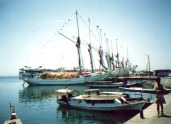 Jakarta is a metropolis by any measure. Though not really popular by tourists, due to its oppressive heat and snarled traffic, the city nevertheless boasts good museums and many interesting examples of colonial architecture, as well as an array of shops, good restaurants and performing arts venues. I had a super delicious lunch at a Spanish restaurant but i forgot to make a note of the name.
Jakarta is a metropolis by any measure. Though not really popular by tourists, due to its oppressive heat and snarled traffic, the city nevertheless boasts good museums and many interesting examples of colonial architecture, as well as an array of shops, good restaurants and performing arts venues. I had a super delicious lunch at a Spanish restaurant but i forgot to make a note of the name.
To the north lies the old harbor, Sunda Kelapa, with a mile long wharf in use since 1817. This is where Jakarta began more than 1500 years ago, as a Hindu spice-trading post. Moored there today are scores of Bugis pinisi - two masted schooners that still ply the waters between Java, Kalimantan and Sulawesi. A morning or evening walk through this nautical hustle and bustle is one of Jakarta's unforgetable experiences. (See picture above).
West Java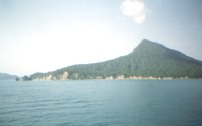 Escape from Jakarta: Besides the Thousand Islands reachable by ferry, another quick getaway from the capital is a journey to Java's sandy and secluded West Coast Beaches facing the Sunda Strait where you can enjoy swimming and snooze on the beach within three to five hours leaving the city.
Escape from Jakarta: Besides the Thousand Islands reachable by ferry, another quick getaway from the capital is a journey to Java's sandy and secluded West Coast Beaches facing the Sunda Strait where you can enjoy swimming and snooze on the beach within three to five hours leaving the city.
The infamous volcanic islands of Krakatau lies just 94 miles to the southwest of Jakarta. From the port of Lubuan,charter a boat for the smooth two hour journey out to the volcanoes. Though dormant for centuries, Krakatau achieved instant infamy in 1883 when it erupted with cataclysmic force, ripping out a huge chunk of the earth's crust and forming a monstrous submarine caldera. The sea rushed in, causing tidal waves that claimed more than 35.000 lives. Undersea activity continued for decades thereafter, producing a newcomer with a gaping half-crater: Anak Krakatau ("son of Krakatau")
The town of Bogor is only an hour away from Jakarta via the new expressway. Here, the glorious Botanical Gardens houses more than 15.000 species of tropical plants and trees, plus orchid nurseries, a zoological museum and a vast botanical library.
The breathtking peaks around Bandung are easy to visit. Tangkuban prahu ("upturned boat") volcano lies only 20 miles to the north of the city of Bandung. Here, cold mountain mists and sulfurous fumes swirl about jagged ridges. Visit the Ciater hot springs beyond th eTangkuban prahu exit for a meal and a soothing soak in the piping-hot pools.
Yogyakarta
The noble city of Yogyakarta (Yogya) sits astride a broad, green crescent of fertile ricelands on the southern flanks of Mount Merapi , where average population densities soar as high as 3000 persons per square mile. Cultural attractions abound as well - for this was the site of Central Java's two great MAtaram empires. Yogyakarta is today a bastion of Javanese traditional life, as well as the jumping off point for visits to the fabled monuments of Borobudur and Prambanan. A visit to one of the hundred-odd candis or ancient stone monuments that lie scattered about the dramatic volcanic landscaoes of Central Java is unforgetable. The legendary stupa of Borobodur located 26 miles to the north of Yogya, is the world's largest Buddhist monument. Two world wars, the Depression and severazl earthquakes left Borobudur in a sorry state by the time UNESCO finally sponsored a fund-raising drive and feasibility study. In 1973, the massive project finally got underway. it is estimated that it originally took 30.000 stonecutters, 15.000 carriers and thousands of masons 50 to 75 years to build Borobudur. Ten miles to the east of Yogyakarta, in the center of a plain that is literally littered with ancient ruins, lies the complex of Prambanan The complex consists of eight structures. The three main temples are atrayed north to south, with the large Loro Jonggrang ("slender maiden") Shiva shrine in the middle, flanked on either side by slightly smaller shrines dedicated to Vishnu and Brahma. Not to be missed is the Ramayana Ballet, held under a full moon over four consecutive nights during the dry season (May-october) in front of Loro Jonggrang.
Central and Eastern Java.
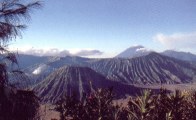 The north coast, once the site of Java's busiest and richest trading ports, is now one of the finest areas for handicrafts and the scene of eccentric palaces, holy graves, ancient mosques, bustling markets and colorful Chinese temples. Cirebon is famous both for its seafood and its colorful past. At one time the seat of a powerful sultanate, it has two major palaces. The Kraton Kasepuhan displays a fascinating blend of Javanese, Chinese, Islamic and European influences. The Masjid Agung (Grand Mosque) next door was erected around 1500, making it one of the oldest Islamic landmarks on Java. The Kraton Kanoman behind the market has European furnishings and walls studded with Delft tiles and Chinese porcelain. What the north may lack in scenic beauty it makes up for in batik. About 138 miles east of Cirebon is a town called Pekalongan that announces itself on roadside pillars as "Kota Batik" - Batik City. Apart from the many factories and stores lining the streets, Pekalongan justifies this sobriquet by producing some of the finest and most highly prized batik on Java.
The north coast, once the site of Java's busiest and richest trading ports, is now one of the finest areas for handicrafts and the scene of eccentric palaces, holy graves, ancient mosques, bustling markets and colorful Chinese temples. Cirebon is famous both for its seafood and its colorful past. At one time the seat of a powerful sultanate, it has two major palaces. The Kraton Kasepuhan displays a fascinating blend of Javanese, Chinese, Islamic and European influences. The Masjid Agung (Grand Mosque) next door was erected around 1500, making it one of the oldest Islamic landmarks on Java. The Kraton Kanoman behind the market has European furnishings and walls studded with Delft tiles and Chinese porcelain. What the north may lack in scenic beauty it makes up for in batik. About 138 miles east of Cirebon is a town called Pekalongan that announces itself on roadside pillars as "Kota Batik" - Batik City. Apart from the many factories and stores lining the streets, Pekalongan justifies this sobriquet by producing some of the finest and most highly prized batik on Java.
The metropolis of East Java is Surabaya, the largest seaport in the archipelago before the turn of the century and this days a sprawling city of over a 4 million people. Just north of Surabaya in the Java Sea is the island of Madura, famous for its annual kerapan sapi or bull races. According to the locals, this sport began many centuries ago when plow teams races one another across the rice fields. Today's racing bulls are specially bred and are a considerable source of island pride. Races take place in August and September with the Grand Finale in Pamekasan, the island's capital.
Nature lovers will revel in the moonscapes of Mount Bromo, the Yang Plateau and the Ijen Crater. The trek up Bromo for sunrise is a must on a backpacking trip across Java. Those who don't want to walk can hire ponies at Cemoro Lamang village. Either way, the ascent starts before daybreak with most of the climbing done in the dark.
At the far eastern tip of Java is Baluran National Park, a massive nature reserve which comprises volcanoes, seashore, grasslands, swamps and tropical forests. The wildlife inventory includes wild buffalo, deer and leopards. On the southern coast near Sukamade is the Meru Betiri Reserve, where giant sea turtles lay their eggs on black-sand beaches at midnight. Heavy rain in this area has created dense rainforst which is the last refuge of the nearly extinct Javan tiger.
Bali...The Paradise Island
A short ferry trip brings travelers and locals from Java to earth's Paradise...Since this is place is my personal most favorite destination in this world, i could'nt resists to create a separate homepage on Bali. You can continue reading here of course and follow the whole trip throughout Indonesia, after at the bottom of this page is a link to the Bali Hints & Tips section, or if you prefer, you can Click Here and go straight to this fabulous destination.
Sumatra
 The great island of Sumatra - third largest in the archipelago and sixth largest in the world - is Indonesia's most important territory. In just about every sense - strategically, economically and politically - Sumatra has always formed a pivotal "backbone" for the nation.
The great island of Sumatra - third largest in the archipelago and sixth largest in the world - is Indonesia's most important territory. In just about every sense - strategically, economically and politically - Sumatra has always formed a pivotal "backbone" for the nation.
Sumatra's largest nature park - the 600.000-acre (1.5 million hectare Kerinci-Seblat Reserve - straddles the frontier between Jambi and West Sumatra provinces. The focus of the park is Sungai Penuh, from where footpaths lead in all directions. The terrain here is amazingly diverse, from high-altitude marshlands around Danau Bentu, to the rainforests of Gunung Seblat, to Gunung Tujuh volcano and its crater lake. The wildlife inventory includes rare animals like elephants, rhinos, tigers, tapirs, clouded leopards and sun bears. Mythological creatures are also said to abound, including the orang pendek (half-man, half-ape) and the cigau (half-lion, half-ape).
A single feature dominates the geography of north-central Sumatra - the massive oval shape of Lake Toba. Situated on a high plateau, this blue-green body of water is the focus of the Batak Highlands.
Prapat is a large resort town on the lake's eastern shore, with hotels, golf course and a lively Saturday market. But the best place to experience Toba's spell is Samosir Island in the middle of the lake. Boats ply daily between Prapat and Samosir, and once on the island there is no shortage oflosmen (cheap accomodation) to choose from. Tuk Tuk is the main tourist village, with a community hall for Batak dances. A number of other villages are worth visiting, especially Tomok and Simanindo. But the most interesting place on the whole island is probably Ambarita, with three megalithic complexes. One of them includes a cannibal's breakfast table: the victim was beaten to death, decaptated, chopped on a flat stone, cooked with buffalo meat and served as the raja's breakfast, washed down with blood.
The sprawling, crowded city of Medan is the largest city on Sumatra and the gateway to the north. Medan's two most important structures are the Masjid Raya (Grand Mosque) and the Istana Maimun (Sultan's Palace),built in the flamboyant Italian rococo style. The palace is still residence of the sultan's descendants, but may be visited during the day. Across the Deli River is the European town, with wide avenues flanked by huge colonial villas and gardens. The quick way to reach Aceh is on the Trans-Sumatran Highway along the coast from Medan. But a much more spectacular route follows the Alas Valley. The first stop on this route is Brastagi, a hill resort and market town 42 miles south-west of Medan. Brastagi has a mild climate, ideal for growing french beans, carrots, tomatoes, passion fruit, floxers and oranges. The Karo Batak tribe lives in this region and their massive wooden clan houses can be visited. A narrow road winds up the Alas River Valley through the Mount Leuser Nature Reserve, named after an 11.372 foot volcano of the same name. This reserve contains some of the island's most spectacular forests, which harbor wildlife like orangutans, rhinos, tigers and elephants. North of the park boundary is Blangkeseren, with numerous old Gayo and Alas clan houses.
Beyond
The Lesser Sundas
 Whereas Java, Sumatra and Borneo are bordered by the shallow Java Sea and have increased their land areas through the accumulation of vast alluvial deposits, the islands to the east of Bali rise from a deep sea bed. The interstices between them have not been "filled in" and this makes for a steppingstone effect of small, adjacent islands with steep slopes, high mountains and very narrow coastal plains.
Whereas Java, Sumatra and Borneo are bordered by the shallow Java Sea and have increased their land areas through the accumulation of vast alluvial deposits, the islands to the east of Bali rise from a deep sea bed. The interstices between them have not been "filled in" and this makes for a steppingstone effect of small, adjacent islands with steep slopes, high mountains and very narrow coastal plains.
LOMBOK: This is an island of startling contrasts and contradictions where Hindu rituals are incorporated into Muslim ceremonies, and lush rainforests back onto arid plains. Lombok has been spared, to a great extent, the more vulgar intrusions of Western culture. From Ampenan, a small road leads north across river estuaries and through coconut groves to the Batu Bolong CLiff Temple. Situated on a high rock formation that just out into the Lombok Strait, the temple is reached via a natural stone arch. Farther North along the coast is beautiful Senggigi Beach, quickly becoming the tourist hub of Lombok with its losmen guesthouses and resort hotels. The attraction is very clear: several miles of unspoiled white-sand beach and a coral reef that is ideal for snorkeling.
Komodo lies between the islands of Sumbawa and Flores, home of the world's largest reptile, the
Several hundreds adult dragons live on Komodo. Adult males can reach 10 feet (3 meters) in length and weigh 330 pounds (150 kg). Females attain only two-third of that size and lay up to 30 eggs at a time. Though you may spot one by walking around the island, the safest and surest way to see a komodo dragon is to arrange a tour with the Indonesian Directorate of Nature Conservation. You will have an excellent opportunity to photograph a group of dragons devouring a goat. Be sure to bring a telephoto lens and keep well away from the lizards - their tails are lethal weapons and their saliva is extremely toxic. A story has been told about a German tourist who explored the island on his own. He never returned out of the forest, found back his camera and hat.
Flores was first explored by the portugese who called it Cabo das Flores (Cape of Flowers) when they passed this way in 1512. One of Flores' most inspiring traditions is the Maha Kudus held once a year at Bajawa. The mass is preceded by a ritual deer hunt in the nearby forest and followed by a lively procession of swordsmen and dancing villagers who follow a crucifix around the town.
Ende is the principal city of Flores. It has a distinctly Islamic flavor, the result of its role as an important Islamic trading post from the 17th to 19th centuries. However, today commerce is largely in Chinese hands. A few hours east of Ende is Keli Mutu, three adjacent volcanic lakes that are considered the island's chief attraction. Two of the lakes are burgundy red, while the third is light turquoise. The residents of this area say that one red lake holds the souls of sorcerers, the other the souls of sinners, while the blue-green lake holds the souls of infants and virgins.
The island of Timor has been known for centuries as a source of fragrant sandalwood. Chinese, Javanese and Islamic traders sailed to the island to obtain the wood. The portuguese and Dutch later fought to control the trade, finally dividing the island into two halves: Dutch in the west and Portuguese in the east. East Timor remained a Portuguese possesion until 1975 when it became independent. A year later, the Indonesian Army rolled across the border and annexed East Timor. Though technically possible, visits to Kupang, the capital of West Timor, are difficult to arrange.
Kalimantan (Borneo)
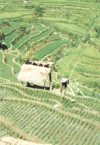 Many exotic and often frightening images are tradtionally associated with Kalimantan, the huge indonesian portion of the island of Borneo. The name alone is not enough to conjure thoughts of dense jungles and steamy swamps, primitive headhunters and savage animals. But Kalimantan today is not the godforsaken backwater that it once was. The island's vast reserves of oil, natural gas, timber and diamonds are now responsible for a hefty chunk of the country's exports, in addition to supplying raw materials for domestic consumption. As a result, there are now daily flights between Jakarta and major coastal cities, where fine tourist-class hotels and restaurants continue to profilate. Yet the dedicated explorer will still have little trouble to finding Dayak villages and wild orangutans in remote upriver jungles.
Many exotic and often frightening images are tradtionally associated with Kalimantan, the huge indonesian portion of the island of Borneo. The name alone is not enough to conjure thoughts of dense jungles and steamy swamps, primitive headhunters and savage animals. But Kalimantan today is not the godforsaken backwater that it once was. The island's vast reserves of oil, natural gas, timber and diamonds are now responsible for a hefty chunk of the country's exports, in addition to supplying raw materials for domestic consumption. As a result, there are now daily flights between Jakarta and major coastal cities, where fine tourist-class hotels and restaurants continue to profilate. Yet the dedicated explorer will still have little trouble to finding Dayak villages and wild orangutans in remote upriver jungles.
The largest city on the southern flank of the island is Banjarmasin, a good jumping off point for visits to the interior. The city is set on an island at the junction of the Barito and Martapura rivers, and the thousands of watercrafts that flit about have earned the city the nickname "Venice of Indonesia". Two hours by river to the west of Banjarmasin is Mandomai, gateway to Dayak villages near Kandangan. Prices for Dayak handicrafts are much lower here than in the city. The largest game reserve in the region is at Cape puting, an animal-rich swampland that includes the Camp Leakey Orangutan Rehabilation Station.
Balikpapan is the island's oil town and the metropolis of East Kalimantan province. most travelers don't stay long, using Balikpapan as a jumping-off point for trips up the Mahakam River into Dayak country. Travelers can book passage aboard the regularly scheduled passenger boats which ply the river, allowing them to stop off at various places of interest. However, time is needed because most of the boats are slow, especially in the wet season when they must fight against stronger currents. Those who prefer organized tours can also arrange these in Tenggarong. Tours which last up to a week are available on riverboats reminiscent of the African Queen. Everything is provided, including food and sleeping gear.
Sulawesi
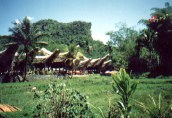 Alltough primarly knwon as the home of two flamboyant ethnic groups, the highland Toraja ans the seafaring Bugis, the oddly shaped island of Sulawesi contains a great variety of exotic peoples, landscapes and natural wonders. Sulawesi's central position within the Indonesian archipelago has contributed greatly to her heterogeneity. Over the centuries, the island has received numerous influences from abroad, serving as a focus for inter-island migrations and trading operations.
Alltough primarly knwon as the home of two flamboyant ethnic groups, the highland Toraja ans the seafaring Bugis, the oddly shaped island of Sulawesi contains a great variety of exotic peoples, landscapes and natural wonders. Sulawesi's central position within the Indonesian archipelago has contributed greatly to her heterogeneity. Over the centuries, the island has received numerous influences from abroad, serving as a focus for inter-island migrations and trading operations.
Dramatic landscapes and remarkable peoples are the hallmarks of South Sulawesi, a province that is rapidly becoming one of the country's major tourist destinations. Ujung Pandang, the provincial capital, is a modern, bustling city of 700.000. Like all major Indonesian cities, it has undergone its share of growing pains in recent years, as the grandeur of the Dutch colonial town gives way to concrete boxes, roads and drainage canals that create a rather bland contemporary look.
Cape Bira is the heart of the Bugis shipbuilding industry. Round-bellied prahu sailing craft are still fashioned here with ancient tools and without the use of metal or nails of any sort. Rituals are employed in all phases of construction, from the selection of teak trees to the launching, to ensure the craft will be seaworthy.
Tucked away amid the rugged peaks and fertile plateaus of south-central Sulawesi are a cluster of isolated tribes called the Toraja or "highland peoples" who maintain many ancient crafts and customs. The Toraja traditionally live in small hamlets perched on hillsides and surrounded by stone walls.
The Toraja are perhaps best known for their elaborate, colorful funeral feasts, offered to make sure the souls of the dead pass into the afterworld in the appropriate manner. The funeral culminates in the ritual slaughter of up to 50 water buffaloes, each with a single stroke of the sword. Coffins are burried in liang (cave tombs) chiseled from bare stone on the sides of sheer cliffs.
Rantepao is the center of Torajaland tourist trade, with small hotels, restaurants and shops catering to foreign visitors. The nearby villages contain bustling markets and traditional houses, where Toraja practice their native crafts of weaving and wood carving and stage rituals and folks dances for themselves and the benefit of tourists. There are several cave tombs in the vicinity, with tau-tau effigies that stare out from the suspended balconies like guards.
North Sulawesi, though less developed than the south, is in many respects the most civilized and scenic area on the island, with dramatic volcanic landscapes, forested highland lakes and exotic wildlife. Manado, the provincial capital, is known for its cleanliness and mixed Indonesian-Chinese-European population. In the Minahasan hills is the Tondano Lake district, with many megalithic monuments. Coconut plantations stretch from miles along the coast, and offshore coral gardens offer opportunities for snorkeling or diving..
Maluku: The Spice Islands
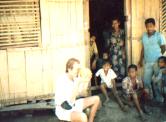 Every schoolkid has heard of the fabled Spice Islands, that source of exotic clove, nutmeg, pepper, cinnamon and marce which changed the course of history. The name Moluccas applied originally to a chain of five small islands (Ternate, Tidore, moti, Mare and Makian) lying just off the west coast of much larger Halmahera. Most inhabitants of this mini-archipelago engaged in tending and harvesting the world's supply of prime cloves. But now the province embraces a total of 999 far-flung islands including the Banda-chain, Ambon, Buru and Ceram. Southeast of kota Ambon is Mount Sirimahu, famous for its outstandind views and prehistoric megaliths. An interesting old village called Soya rests on the side of the mountain, with a Dutch church (1817) and the residence of a former raja.
Every schoolkid has heard of the fabled Spice Islands, that source of exotic clove, nutmeg, pepper, cinnamon and marce which changed the course of history. The name Moluccas applied originally to a chain of five small islands (Ternate, Tidore, moti, Mare and Makian) lying just off the west coast of much larger Halmahera. Most inhabitants of this mini-archipelago engaged in tending and harvesting the world's supply of prime cloves. But now the province embraces a total of 999 far-flung islands including the Banda-chain, Ambon, Buru and Ceram. Southeast of kota Ambon is Mount Sirimahu, famous for its outstandind views and prehistoric megaliths. An interesting old village called Soya rests on the side of the mountain, with a Dutch church (1817) and the residence of a former raja.
Ternate and Tidore islands are two perfectly shaped volcanic cones measuring less than 6 miles in diameter, but each rising to about 5600 feet (1700 meters). For centuries, these were the most important percels of real estate in all of indonesia, for they owned a natural monopoly on the growing of cloves. The 20-minute boat ride from Ternate to Tidore is spectacular and brings with it a change of atmosphere. Soa-Siu, the principal town, has the feel of a Mediterranean fishing village. Whitewashed houses with gabled Iberian archways climb the hill behind the port as a legacy od Spanish times. The sultan's palace and two Spanish forts are now in ruins.
The Banda chain - the "Nutmeg islands" - simply oozes history. The capital Banda Neira rises dramatically from the sea, facing out across the narrow strait to another island. There are two old Dutch Bastions - Fort Belgica(!) and Fort Nassau - plus an old Dutch Reform Church in the center of town. Many of the large mansions of Dutch traders remain in a good state of preservation.BR>
Irian Jaya
The western half of the huge island of New Guinea is called Irian Jaya. Formerly called Dutch New Guinea, it was ceded to Indonesia in 1963 following a brief but boisterous military campaign undertaken by President Sukarno.
Irian Jaya ranks as the most isolated and primitive region of the earth today. Impenetrable mangrove swamps seal much of the island's extensive coastline, while dense jungles and rugged peaks - some of them snowcapped and towering about 16400 feet (5000 meters) - dominate and subdivide the interior. Roads are almost non-existent; air and sea connections are few and far between; most villages in the interior can be reached only by walking up and down treacherous paths, sometimes for weeks.
Partly as a result of this extraordinary fragmentation, the province is home to a widly diverse assortment of peoples and cultures. More than 100 mutally unintelligible languages are spoken in Irian jaya by scores of distinct and colorful tribes, many of wwhom have barely emerged from the Stone Age.
A remarkable flora and fauna thrive on the island. Ferns, orchids and vines interwine with the towering canopy of the lowland dipterocarp rainforest. About 700 species of birds have been identified, including the huge flightless cassowary and fabled "Bird of Paradise". Marsupials like the tree kangaroo, wallaby and flying phalanger inhabit the forests and grasslands. A variety of fierce reptiles, including the crocdile and "death" adder, are much feared by natives. Jayapura, the provincial capital and Irian Jaya's largest city (population 50.000) was founded by the Dutch to lay claim to New Guinea's north-central shore. East of Jayapura is the Yotefa Nature Reserve on Yos Sudarso Bay, with many beautiful beaches and wreckage of several ships sunk during World War II. Farther east along this coast, one can find Sepik people, known for their primitive bark paintings and carved ancestor figures.
The largest and most accessible of the highland areas is the Grand Baliem Valley in Central Irian Jaya, a 45-mile corridor formed by the Baliem River. About 100.000 primitive Dani tribesman inhabit the area, living in tiny settlements scattered across the broad valley floor. The only way in and out is by air - unless you plan to walk for a month - with regular scheduled flights from Jayapura to an airstrip near the village of Wamena. Villages throughout the valley are connected to Wamena by footpaths and an increaing number of crude vehicular tracks. Be sure to bring along warm clothes, sturdy shoes and a backpack. porters and guides may be hired through hotels in Wamena, which can also arrange dance rituals. Many visitors cross over the river and make the three hour trek to Akima, where the chief's grandfather has been mummified and may be seen on payment of a small fee. It's several hours further to Ywika, where the Catholic mission offers comfortable lodgings.



BALI TRAVEL TIPS